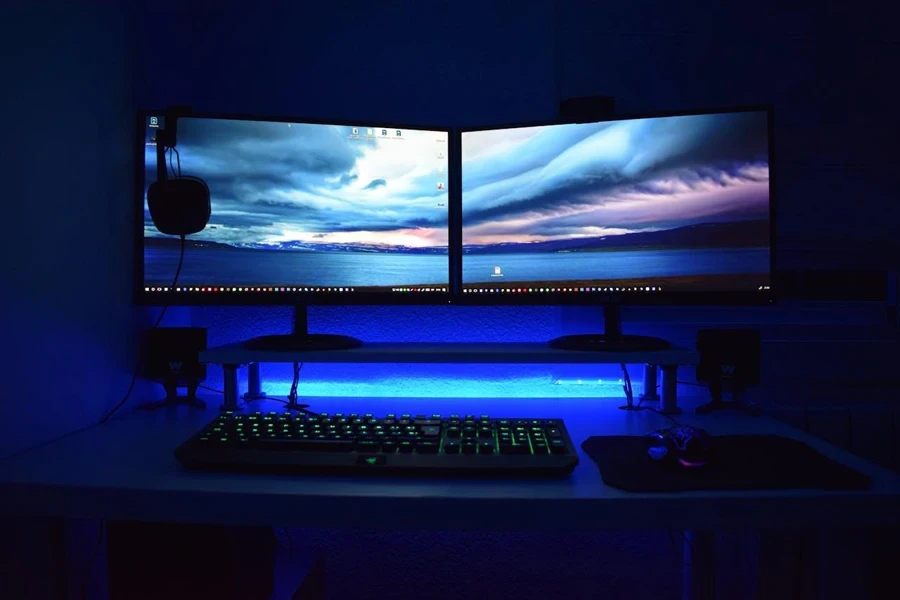Technology has made convergence a tangible reality across different practical applications. Nowadays, products like smartphones and tablets, along with wearables and fitness trackers, are blurring the lines between them. Monitors and TVs are another prime example of devices that are becoming increasingly interchangeable thanks to innovative designs from manufacturers and creative uses by tech enthusiasts.
Read on to explore the potential global market outlook for both monitors and TVs, and discover the key differences between them, as well as the ideal target audience for each product in 2025.
Table of Contents
Monitors vs. TVs: Global market outlook
Monitors vs. TVs: Key differences all sellers should know
External features
Internal features
Additional performance features
Monitors vs. TVs: Identifying the ideal customer segments
Target customers for monitors
Target customers for TVs
Pick the right screen
Monitors vs. TVs: Global market outlook

Often referred to as PC or computer monitors, the global market for monitors designed for computer use is predicted to grow at a moderate compound annual growth rate (CAGR) of 5.36% throughout the forecast years between 2019 and 2029. By 2029, it’s expected to reach a market size of US$ 58 billion, up from US$ 44.67 billion in 2019. The steady increase in demand for education, office, and remote work setups is among the main drivers of this growth, alongside other new advanced technologies that support faster response times and built-in cameras for remote collaboration needs.
In a similar upward trajectory, the global market for gaming monitors is projected to reach US$ 18.4 billion by 2033, nearly double the estimated value of US$ 9.8 billion in 2023, growing at a moderate CAGR of 6.5% over the forecast period of 2023 to 2033. Rising demand for high-quality graphics, immersive experiences, and the increasing popularity of online gaming and esports have contributed to these, although they are typically more expensive than PC monitors.
The global TV market, in contrast, is significantly more expanded than the worldwide monitor market, with estimates indicating it as around 2-4 times larger, depending on the source. For instance, one market research pegged global television revenue at an impressive US$ 259.16 billion in 2021. A more conservative estimate from Statista however, places this figure at over US$ 97 billion by 2024.
Even in the newer segment of smart TVs, the global market value reached US$ 197.82 billion in 2022—about three times the projected global market for monitors. What is more universally agreed upon, however, is the robust growth rate of TVs. With a projected promising double-digit CAGR of 10.0% for the TV market from 2022 to 2028 and 11.4% for smart TVs from 2023 to 2030, there is clearly strong market confidence in the global television industry.
Monitors vs. TVs: Key differences all sellers should know

While everyone may know that there are certain distinctions between monitors and TVs, exactly how much is the difference between monitors and TVs? Their differences can be fundamentally classified into three main categories:
External features
Monitors and televisions, though they look alike in terms of their physical appearances, still possess some distinct differences, especially regarding size and certain specific external features like available ports, speakers, and remote controls.
From a size perspective, 24-inch monitors are rather common, with screen sizes for monitors typically ranging from 21 to 24 inches, even though these sizes are hardly acceptable for TVs. Today, the standard “entry-level” TV size starts at a minimum of 43 inches, with 32-inch models becoming increasingly less popular since most consumers now expect much larger screens.
In fact, it’s getting relatively more common to find XXL screen TVs in various commercial and home theater settings, with reports confirming that the prices for 97-inch TVs have dropped dramatically to almost half compared to the same season last year. At the same time, the sizes for PC and gaming monitors are also trending larger, with brands like Samsung, for example, readily rolling out models from 32-inch to 55-inch monitors, while Dell has introduced options as large as 65 inches to a whopping 86 inches.
Apart from size, another notable difference between monitors and TVs when it comes to their appearance is the range of control buttons and sound features. Monitors, designed for simpler, more specialized purposes, generally come with fewer control buttons and lack or only come with rather basic sound systems. On the other hand, to support greater functionality and improve user convenience, televisions typically come with multiple physical control buttons and built-in speakers. Some models even feature advanced sound systems, like Dolby Atmos and surround sound, to enhance the viewing experience.
Internal features

The internal features, which ultimately determine the visual quality and viewing experience of display devices, involve some technical specifications such as resolution, aspect ratio, viewing angle, and brightness level.
Among the various tech specs, resolution options like Full HD, 4K (also known as Ultra HD), and even 8K Ultra HD are probably the most familiar to consumers, largely due to the heavy marketing of 4K TVs. These resolution standards also apply to monitors, except that monitors also offer Quad HD, a 1440p resolution that sits between Full HD and 4K.
When paired with a wider aspect ratio that provides more horizontal screen space, higher resolutions also mean higher pixel density on monitors. Pixel density, measured in pixels per inch, has a direct impact on clarity based on screen size and resolution. Depending on screen size and resolution, the basic rule is that the higher the density, the sharper the visual quality.
Naturally, with a smaller screen size, pixel density increases since they are now concentrated over a relatively smaller surface area. In other words, smaller monitors typically deliver sharper, more detailed images than larger TVs with the same resolution, which is why they are ideal for close-up tasks like design work or high-definition gaming.

By comparison, larger-screen TVs normally have lower pixel density due to their bigger surface area, even when both monitors and TVs have the same average 16:9 aspect ratio. This advantage is even more noticeable on monitors with ultra-wide aspect ratios such as 21:9 or 32:9, which are much more common in monitors but rarely seen in TVs.
Lastly, to accommodate larger audiences and more dynamic viewing environments, TVs and monitors are also very different in terms of brightness levels and viewing angles. TVs are generally built with higher brightness and wider viewing angles so that people across a room or within a larger space are able to view the screen clearly even from various angles and distances. Monitors, by contrast, are optimized with lower brightness and narrower viewing angles to reduce eye strain and improve color accuracy, since they’re intended for close-up, single-user setups.
Additional performance features

On top of the must-have internal attributes that determine acceptable visual quality for both TVs and monitors, there are additional performance-oriented features that further distinguish the two types of display devices. These include responsiveness and connectivity functions, such as refresh rate, split-screen or multitasking capabilities, as well as specific connectivity options.
From a responsiveness perspective, monitors exhibit significantly more advanced performance compared to TVs, owing to their much lower input lag and faster refresh rates that support gaming, professional design, and interactive applications. These outstanding attributes ultimately translate into agility and precision that fast-paced activities, especially gaming and video editing tasks can fully leverage.
TVs, by contrast, typically have their refresh rates capped at around 60-120Hz only, while monitors—particularly gaming models—can reach 120Hz to 240Hz or even 500Hz to accommodate demanding applications, making TVs less preferred and less suitable for high-speed gameplay.
Moreover, ultra-wide and curved monitors are especially suited for multitasking and split-screen setups, due to their wider aspect ratios that allow for efficient side-by-side applications, a capability that is primarily supported by the screen’s width and aspect ratio. Conversely, televisions, even smart TVs, often lack the ability to perform multiple tasks simultaneously and struggle with split-screen features due to their limited capabilities.

Related to connectivity options, while both monitors and TVs are well-equipped, their connectivity focuses are fundamentally distinct. Monitors are lauded for their variety of input jacks that allow connections to multiple computer-related devices, such as DisplayPort, USB-C, and DisplayPort over USB-C. These digital connectivity ports enable high-speed, high-quality video and data transmission that monitors frequently require, especially for professional or multitasking setups.
In comparison, TVs are more equipped with media device connection ports that support entertainment or multimedia devices like gaming consoles, streaming sticks, and DVD players. So it’s common for them to come with multiple HDMI ports and AV inputs rather than advanced digital connectivity ports found on monitors.
Monitors vs. TVs: Identifying the ideal customer segments
Based on all the key differences highlighted and compared above, it’s evident that monitors and TVs are each designed with different specific target customers in mind. To better determine the ideal customers for each of them from a seller’s perspective, let’s examine their target audiences, focusing on how well each aligns with customer needs. This includes analyzing the use cases, their market positioning, and specialization based on core features and connectivity, as well as comfort and ergonomic appeal.
Target customers for monitors

First of all, from a specialization and use-case perspective, monitors are clearly best-suited for users with high-performance demands. Gamers and professionals, such as designers and video editors, are the prime members of this group of customers. They typically require detailed image quality, low input lag, fast refresh rates, and multitasking capabilities like split-screen support, all of which are qualities that any standard to high-end monitor can offer.
Furthermore, the fact that monitors come with multiple input jacks also signifies a wide range of connections to various computer-related devices. Such versatility enables simultaneous, seamless integration with laptops, desktops, and even tablets. Combined with their typically smaller screen sizes, this compact design and adaptability make monitors well-suited for space-limited homes and urban offices, especially when considering how much a monitor costs as a practical, single-screen solution.
The recent work-from-home trend also brings us to another key benefit of monitors over TVs: lower brightness levels and superior image detail. These qualities make monitors stand out for eye comfort during close-up usage, rendering them ideal for health-conscious users and those who spend extended hours facing a screen. All of these adaptable features accentuate the importance of multi-purpose monitors in supporting both work and personal tasks in today’s remote and hybrid work environments.
Target customers for TVs

Comparatively, the primary customers for televisions remain the traditional audience: individuals and families looking for affordable entertainment options that can be enjoyed together. In fact, when considering screen sizes and relative prices, TVs indeed offer a significantly higher price-to-performance ratio compared to monitors, particularly when factoring in how much a TV costs for the larger sizes it offers. Besides screen size, TVs typically have wider viewing angles that allow everyone to enjoy a clear, undistorted picture no matter which spots in the room they are in.
The entertainment-focused features of larger-screen size TVs also make them ideal for media enthusiasts who want a true cinematic experience at home. Advanced immersive display technologies like OLED (Organic Light Emitting Diode) and HDR (High Dynamic Range) deliver stunning image quality, closely resembling the immersive viewing experience that one may find in high-end cinemas.
Besides OLED TVs, TVs remain a top choice for those who value direct access to streaming apps, advanced voice controls, and seamless integration with other smart home devices. Owing to overlapping features like built-in operating systems, streaming apps, and Wi-Fi and Bluetooth connectivity, the rise of smart monitors is gradually diluting the distinctions between them and smart TVs. However, the combination of large screens, shared viewing suitability, and immersive experiences means that large-screen smart TVs still stand out as a more versatile and accessible option for households as a whole.
Pick the right screen

While TVs and monitors are both under the same display technology device category, they each have rather significant differences across various aspects, including their global market sizes. Monitors, for example, represent a relatively niche and specialized market when compared to TVs, holding a much smaller global market share. Conversely, TVs continue to command a larger and more dynamic worldwide market presence, estimated to be about 2–4 times greater than that of monitors.
Even though they share certain external traits that make them appear similar at first glance, monitors and TVs differ fundamentally in both internal and external design as well as in their expected performance capabilities. It’s hence important for sellers to pick the right screens based on their respective target customers, as each device type is distinctly suited to specific use cases, market positioning, specialized features, connectivity, and ergonomic appeal.
For more details about differences between other similar tech products, browse through Chovm.com Reads to discover additional wholesale business and sourcing ideas. Also, seize the opportunity to enhance logistics efficiency by exploring the logistics insights shared here, and remember to return regularly for new strategies and growth ideas.





 বাংলা
বাংলা Nederlands
Nederlands English
English Français
Français Deutsch
Deutsch हिन्दी
हिन्दी Bahasa Indonesia
Bahasa Indonesia Italiano
Italiano 日本語
日本語 한국어
한국어 Bahasa Melayu
Bahasa Melayu മലയാളം
മലയാളം پښتو
پښتو فارسی
فارسی Polski
Polski Português
Português Русский
Русский Español
Español Kiswahili
Kiswahili ไทย
ไทย Türkçe
Türkçe اردو
اردو Tiếng Việt
Tiếng Việt isiXhosa
isiXhosa Zulu
Zulu